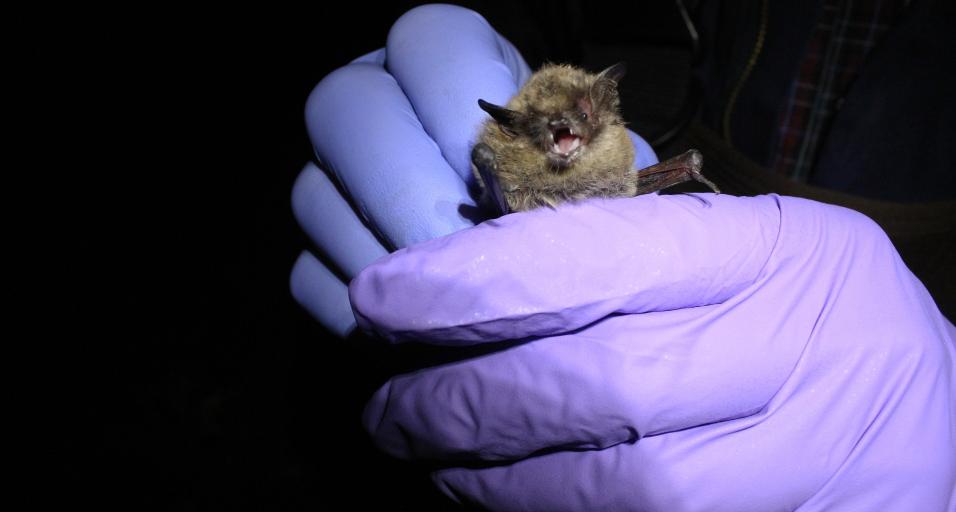Wyoming wildlife researchers working at Fort Laramie National Historic Site in Goshen County have detected the fungus that causes white-nose syndrome (WNS) in bats, the first such finding in the state. Testing of skin-swab samples collected from the wing of a little brown bat confirmed the presence of the fungus Pseudogymnoascus destructans (Pd for short).
The bat was captured on May 16 during proactive surveys for WNS by Wyoming Natural Diversity Database field biologists from the University of Wyoming, working in a project funded by the National Park Service (NPS) for white-nose syndrome surveillance and response. They sent separate samples in May from Fort Laramie bats to Colorado State University’s Veterinary Diagnostic Laboratory and the U.S. Geological Survey’s (USGS) National Wildlife Health Center for independent testing.
The discovery does not mean the bat confirmed with fungus has white-nose syndrome. But the fungus detection in Wyoming signals the continued spread west of a pathogen that has killed millions of bats in the eastern and midwestern U.S. since it first appeared in New York state in 2006. Scientists believe humans accidentally brought the Pd fungus from Eurasia to the U.S. To date, the disease has been found in 32 states and seven Canadian provinces.
Further testing is underway on tissue samples from Fort Laramie bats to confirm if they have WNS. The Fort Laramie finding follows another first instance earlier in May in South Dakota, where the Wyoming field team detected Pd fungus on five bats in Badlands National Park.
“This is a saddening discovery. Bats are important species because they are incredible predators of insects,” said Tim Woolley, the Wyoming Game & Fish Department’s statewide Wildlife and Habitat Management supervisor. As voracious insectivores, bats are vital for healthy ecosystems and contribute at least $3 billion annually to the U.S. agricultural economy through pest control and pollination.
“Humans and their pets are not affected by this fungus and the disease it causes,” Woolley added. “But people can help us prevent both from spreading.”
Wyoming and the Park Service are now implementing state and national response plans within the state. The state’s strategy is to increase coordinated management by limiting access to sites where bats roost and hibernate, and by broadening surveys of those sites to monitor any spread of the fungus. Wyoming Game & Fish has been sampling for Pd fungus at known bat roosts since 2014 with no previous detections. The department also implemented strict decontamination measures previously for field personnel who survey bat species, per national standards. (The national WNS plan is at https://www.whitenosesyndrome.org/plan.)
“This detection reveals that Pd is moving even further into the ranges of western bat species,” said Jeremy Coleman, National White-nose Syndrome Coordinator for the U.S. Fish and Wildlife Service. “This is why our ongoing efforts to develop treatments and management strategies to improve survival of affected bats are increasingly important.”
NPS veterinarian Michelle Verant, coordinator of the Park Service's WNS response, said the finding “highlights the value of our proactive collaboration with Wyoming and other states along this geographical leading edge of the disease.”
The Wyoming field team has monitored bats at parks including Fort Laramie for three years, working with the NPS’s Northern Great Plains Inventory and Monitoring Network of 13 park units in Wyoming and three neighboring states. Located in southeastern Wyoming, Fort Laramie is home to at least nine of the 18 bat species known to live in the state. Although the park has no caves or obvious natural features for bat hibernation, the one bat found with the fungus was among dozens captured for sampling near a bat house structure on park property that supports a large maternity colony of little brown bats.
“We are looking beyond ‘Why here?’ to embrace an opportunity for informed science at Fort Laramie to help stop the spread of this insidious disease,” said park Superintendent Tom Baker.
State and federal agencies throughout the West need the help of outdoors enthusiasts to slow the spread of white-nose syndrome. The best way is to stay out of closed caves and mines, and to decontaminate hiking and caving boots and gear before and after visiting or touring caves and other places where bats live. If you see a sick or dead bat, report it to park rangers or state biologists but do not handle. Climbers and cavers who have used gear or clothing in WNS-infected areas should not re-use them in areas not already known to have Pd fungus. (National decontamination guidance is at https://www.whitenosesyndrome.org/topics/decontamination.) Finally, before packing for home, check canopies, umbrellas and other outdoor items for bats that may have roosted in a nook or cranny.
Additional information and resources:
- National white-nose syndrome website: https://www.whitenosesyndrome.org/
- National Park Service white-nose subject pages, with videos, photos, maps: https://www.nps.gov/subjects/bats/white-nose-syndrome.htm
- Wyoming Game & Fish Department’s WNS webpage:
- Map of WNS occurrence by county: https://www.whitenosesyndrome.org/resources/map
- Fish & Wildlife’s WNS pages on Facebook (www.facebook.com/usfwswns) and Twitter (www.twitter.com/usfws_wns)
PHOTOS ATTACHED, CAPTIONS BELOW
- — Undated photo of a field biologist examining a long-legged myotis bat (photo credit: Leandra Boodoo, Wyoming Natural Diversity Database)


